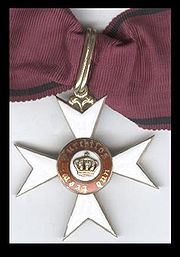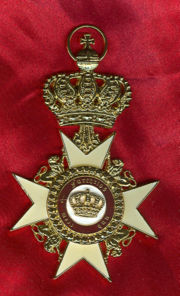
Order of the Crown (Württemberg)
Encyclopedia


Württemberg
Württemberg , formerly known as Wirtemberg or Wurtemberg, is an area and a former state in southwestern Germany, including parts of the regions Swabia and Franconia....
.
History
First established in 1702 as the St.-Hubertus-Jagdorden (Order of St Hubert), in 1807 it was renamed the "Ritterorden vom Goldenen Adler" (Order of the Golden Eagle) by Frederick IFrederick I of Württemberg
Frederick I William Charles of Württemberg was the first King of Württemberg. He was known for his size: at and about , he was in contrast to Napoleon, who recognized him as King of Württemberg.-Biography:...
, and on 23 September 1818 renewed and restructured (at the same time as the civil orders) by William I
William I of Württemberg
William I was the second King of Württemberg from October 30, 1816 until his death.He was born in Lüben, the son of King Frederick I of Württemberg and his wife Duchess Augusta of Brunswick-Wolfenbüttel .-First marriage:...
as the "Order of the Württemberg Crown" with (initially) 3 classes (grand cross, komtur
Komtur
Komtur was a rank within military orders, especially the Teutonic Knights. In the State of the Teutonic Order, the Komtur was the commander of a basic administrative division called Kommende . A Komtur was responsible for the alimentation of the Knights by the yield from the local estates, he...
, knight). In 1918 the order was expanded and changed
Its motto reads : Furchtlos und treu (fearless and true). Until 1913 the higher orders were restricted to the nobility. In descending order, its ranks were:
- Grand cross for sovereigns
- Grand cross
- Komtur with star (since 1889)
- Komtur
- Honour cross / Ehrenkreuz (Steckkreuz since 1892)
- Knight (since 1892 with golden lions, and since 1864 also with a crown, as a special honour)
- Gold Verdienstmedaille (service medal)
- Silver Verdienstmedaille (abolished 1892)
Cross
The order's cross was a white enameled Maltese cross with gold lions in its four angles. The lions came as standard for the grand cross and Komtur, but were only on knight's crosses as a special honour. On the upper arm, a golden crown was secured by means of two gold bands, from which - except in the honour cross in stuck form - the cross hung. The medallion was gold and blue on the front, and in the middle were the golden initials of king Frederick I and a crown - on the back was a golden crown, on red. All grades could since 1866 be awarded with swords. With the changes of 1890, the swords were only granted in awards of a higher class. Since 1892 the lowest grades (1870-1886 knight 2nd class, after that honour-cross) also had the special honours of golden lion and (since 1864) lion added.Stars
The grand-cross was a silver 8-pointed star in whose middle was a reduced cross in a medallion with a circular motto in the centre. Sovereigns received the star in gold. The Komtur (since 1889 no longer of the Komtur with star) had a 4-pointed silver star whose rays went through the cross angles.Ribbon
The ribbon was carmineCarmine
Carmine , also called Crimson Lake, Cochineal, Natural Red #4, C.I. 75470, or E120, is a pigment of a bright-red color obtained from the aluminum salt of carminic acid, which is produced by some scale insects, such as the cochineal beetle and the Polish cochineal, and is used as a general term for...
red with black stripes and carmine borders. Members of reigning houses received insignia of the grand-cross with a ribbon in scarlet
Scarlet
Scarlet may refer to:* Scarlet , a bright tone of red that is slightly toward orange* Scarlet , type of woollen cloth common in medieval England* Scarlet , women's magazine in the UK* Scarlet , 1995...
.
Awards
Many awards were made - in the First World War alone, the numbers were:- Gold Verdienstmedaille: 141
- Knight cross with swords: insgesamt ca. 350
- Knight cross with swords and lions: 80
- Ehrenkreuz with swords: ca. 160
- Komtur with swords: 75
- Komtur with star and swords: 6
- Grand cross with swords: 6
As an extraordinary instance, the grand-cross "in Brillanten" was granted to Reichskanzler Otto von Bismarck
Otto von Bismarck
Otto Eduard Leopold, Prince of Bismarck, Duke of Lauenburg , simply known as Otto von Bismarck, was a Prussian-German statesman whose actions unified Germany, made it a major player in world affairs, and created a balance of power that kept Europe at peace after 1871.As Minister President of...
in 1871.

